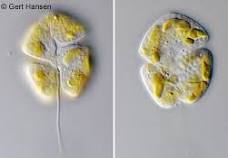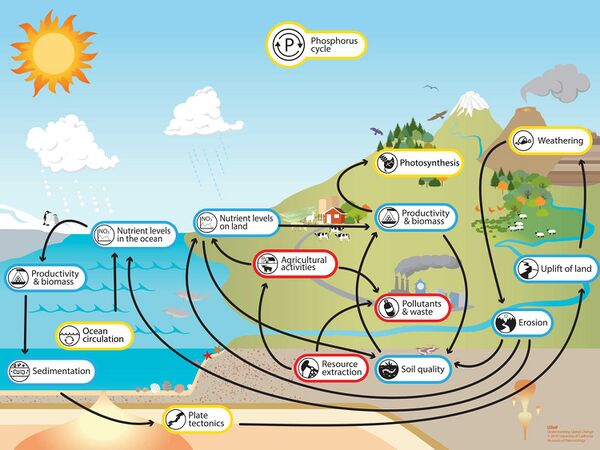Karenia milkimotoi
Karenia mikimotoi
Classification
Eukarya; Sar; Alveolata; Dinophyceae; Gymnodiniales; Kareniaceae
Species
|
NCBI: [1] |
Dinoflagellate Karenia mikimotoi
Description and Significance
Karenia mikimotoi is a dorsoventrally flattened photosynthetic algae that when activated appears as a yellow-brownish color. These cells either lack a true chloroplast or have a shrunken chloroplast. Once activated it grows rapidly in cold water. Intense algae growth has been connected to large fish kills and marine animal kills. The marine animals killed can include fish, crabs, sea urchins, octopus, whelks, chitons, and bivalves (Iwataki et al., 2022). This is important because fish kills are harmful to marine environments and the people who use the marine environments to survive.
Genome Structure
Members of the Karenia family are eukaryotes, meaning their genome structure is linear. Of the Karenia family K. mikimotoi has the third largest genome being 53.4.1 ± 3.05 pg DNA/cell. Of the sequenced DNA of K. mikimotoione chromosome is considered the AG-chromosome due to the amount of arginine and guanine it contains. It was also found that K. mikimotoi contains numerous sections of recombinant DNA and nucleolar organizer regions (Cuadrado et al., 2019).
Cell Structure, Metabolism and Life Cycle
The cell structure of Karenia mikimotoi is hard to describe due to numerous strains identified worldwide that all have different morphologies. However, there have been consistent findings of external stalked pyrenoids (Li et al., 2019). These findings support the idea that there might be sub-species of K. mikimotoi.
K. mikimotoi gains energy through hydrolysis reactions of ATP to ADP. However, in recent years there has been an increase of phosphorus in the oceans where K. mikimotoi is mainly found. This increase has led to an increase in the utilization of dissolved organic phosphorus to create ATP resulting in more growth (Huang et al., 2023).
Ecology and Pathogenesis
Karenia mikimotoi was first noticed in the coastal waters of Japan in the 1930’s. Since then there have been more documented cases in the coastal waters surrounding Japan, Ireland, Norway, and New Zealand. K. mikimotoi is a bloom-forming dinoflagellate that infects fish causing large fish kills and can affect people who eat infected fish as well. These algae blooms also affect shellfish and other invertebrates that habit the infected waters (Li et al., 2019). The fish kills have greatly impacted marine aquaculture.
References
Cuadrado, Á., De Bustos, A., & Figueroa, R. I. (2019, February 28). Chromosomal markers in the genus karenia: Towards an understanding of the evolution of the chromosomes, life cycle patterns and phylogenetic relationships in dinoflagellates. Scientific reports. https://www.ncbi.nlm.nih.gov/pmc/articles/PMC6395649/
Huang, X.-L., Zhuang, Y.-Q., Xiong, Y.-Y., Li, D.-W., & Ou, L.-J. (2023, October 18). Efficient modulation of cellular phosphorus components in response to phosphorus deficiency in the dinoflagellate Karenia mikimotoi. American Society of Microbiology. https://journals.asm.org/doi/pdf/10.1128/AEM.00867-23
Iwataki, M., Lum , W. M., Kuwata, K., Takahashi, K., Arima, D., Kuribayashi, T., Kosaka, Y., Hasegawa, N., Watanabe, T., Shikata, T., Isada, T., Orlova, T. Yu., & Sakamoto, S. (2022, February 23). Morphological variation and phylogeny of Karenia selliformis (Gymnodiniales, Dinophyceae) in an intensive cold-water algal bloom in Eastern Hokkaido, Japan. Harmful Algae. https://www.sciencedirect.com/science/article/pii/S1568988322000336
Karenia Mikimotoi (Miyake & Kominami ex oda) G. hansen & Ø. moestrup. Karenia mikimotoi (Miyake & Kominami ex Oda) G. Hansen & Ø. Moestrup | Nordic Microalgae. http://nordicmicroalgae.org/taxon/Karenia%20mikimotoi
Li, X., Yan, T., Yu, R., & Zhou, M. (2019, November 20). A review of Karenia Mikimotoi: Bloom events, physiology, toxicity and toxic mechanism. Harmful Algae. https://www.sciencedirect.com/science/article/pii/S1568988319301751#:~:text=Classification%20and%20morphology-,K.,Watarai%20District%2C%20Honshu%2C%20Japan.
Phosphorus. Understanding Global Change. (2020, September 10). https://ugc.berkeley.edu/background-content/phosphorus/
U.S. National Library of Medicine. Taxonomy browser (candidatus nitrosarchaeum limnium BG20). National Center for Biotechnology Information. https://www.ncbi.nlm.nih.gov/Taxonomy/Browser/wwwtax.cgi?id=859192
Author
Page authored by Mackenzie H. Deck, student of Prof. Bradley Tolar at UNC Wilmington.


